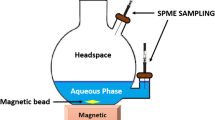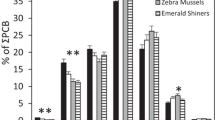Abstract
Using theoretical molecular descriptors as well as partial least squares (PLS) regression, two quantitative structure-activity relationship (QSAR) models were developed for depuration rate constants (k d) of polychlorinated biphenyls (PCBs) in two species of mussels, Perna viridis and Dreissena polymorpha. The cross-validated Q 2cum (an indicator of fitting of goodness) values for the two models are 0.501 and 0.756, and the standard deviation (SD) is 0.084 and 0.076, respectively. The achievement of satisfactory Q 2cum and low SD values indicates good predictive ability and precision of the two models. The significant descriptors governing lgk d include polarizability (α), molecular volume (M V), molecular weight (M w), molecular surface area (S), and total energy (TE). The key descriptors in the models reflect that van der Waals interactions play a dominant role in the depuration of PCBs. The depuration of PCBs in the two mussel species may be mainly attributed to the biota-water phase partitioning processes.
Similar content being viewed by others
References
Naito W, Jin J C, Kang Y S, Yamamuro M, Masunaga S, Nakanishi J. Dynamics of PCDDs/DFs and coplanar-PCBs in an aquatic food chain of Tokyo Bay. Chemosphere, 2003, 53(4): 347–362
Wan Y, Hu J Y, Yang M, An L H, An W, Jin X H, Hattori T, Itoh M. Characterization of trophic transfer for polychlorinated dibenzo-pdioxins, dibenzofurans, non- and mono-ortho polychlorinated biphenyls in the marine food web of Bohai Bay, north China. Environ Sci Technol, 2005, 39(8): 2417–2425
Safe S. Polychlorinated biphenyls (PCBs), dibenzo-p-dioxins (PCDDs), dibenzofurans (PCDFs) and related compounds: Environmental and mechanistic considerations which support the development of toxic equivalency factors (TEFs). Cri Rev Toxicol, 1990, 21(1): 51–58
Iwata H, Watanabe M, Okajima Y, Tanabe S, Amano M, Miyazaki N, Petrov E A. Toxicokinetics of PCDD, PCDF, and coplanar PCB congeners in Baikal Seals, Pusa sibirica: Age-related accumulation, maternal transfer, and hepatic sequestration. Environ Sci Technol, 2004, 38(18): 3505–3513
Galassi S, Bettinetti R, Neri M C, Jeannot R, Dagnac T, Bristeau S, Sakkas V, Albanis T, Boti V, Valsamaki T, Falandysz J, Schulte-Oehlmann U. A multispecies approach for monitoring persistent toxic substances in the Gulf of Gdańsk (Baltic sea). Ecotoxicol Environ Saf, 2008, 69(1): 39–48
Riva C, Binelli A, Provini A. Evaluation of several priority pollutants in zebra mussels (Dreissena polymorpha) in the largest Italian subalpine lakes. Environ Pollut, 2008, 151(3): 652–662
Morrison H, Yankovich T, Lazar R, Haffner G D. Elimination rate constants of 36 PCBs in zebra mussels (Dreissena polymorpha) and exposure dynamics in the Lake St. Clair-Lake Erie corridor. Can J Fish Aquat Sci, 1995, 52(12): 2574–2582
Uno S, Shiraishi H, Hatakeyama S, Otsuki A. Uptake and depuration kinetics and BCFs of several pesticides in three species of shellfish (Corbicula leana, Corbicula japonica, and Cipangopludina chinensis): Comparison between field and laboratory experiment. Aquat Toxicol, 1997, 39(1): 23–43
Dai J Y, Jin L J, Yao S C, Wang L S. Prediction of partition coefficient and toxicity for benzaldehyde compounds by their capacity factors and various molecular descriptors. Chemosphere, 2001, 42(8): 899–907
Wei D B, Zhang A Q, Wu C D, Han S K, Wang L S. Progressive study and robustness test of QSAR model based on quantum chemical parameters for predicting BCF of selected polychlorinated organic compounds. Chemosphere, 2001, 44(6): 1421–1428
Wang X D, Lin Z F, Yin D Q, Liu S S, Wang L S. 2D/3D-QSAR comparative study on mutagenicity of nitroaromatics. Sci China Ser B-Chem, 2005, 48(3): 246–252
Wang Z Y, Han X Y, Zhai Z C. QSPR to aqueous solubility (lgS w) of alkyl (1-phenylsulfonyl) cycloalkane-carboxylates using MLSER model and ab initio. Chemosphere, 2006, 62(3): 349–356
Chen J W, Li X H, Yu H Y, Wang Y N, Qiao X L. Progress and perspectives of quantitative structure-activity relationships used for ecological risk assessment of toxic organic compounds. Sci China Ser B-Chem, 2008, 51(7): 593–606
Chen J W, Wang L S. Using MTLSER model and am1 hamiltonian in quantitative structure-activity relationship studies of alkyl (1- phenylsulfonyl) cycloalkane-carboxylates. Chemosphere, 1997, 35(3): 623–631
Amat L, Carbó-Dorca R. Simple linear QSAR models based on quantum similarity measures. J Med Chem, 1999, 42(25): 5169–5180
Liu X H, Wang B, Huang Z, Han S K, Wang L S. Acute toxicity and quantitative structure-activity relationships of α-branched phenylsulfonyl acetates to Daphnia magna. Chemosphere, 2003, 50(3): 403–408
Svante W, Michael S, Lennart E. PLS-regression: a basic tool of chemometrics. Chemometr Intell Lab, 2001, 58(1): 109–130
Tanabe S, Tatsukawa R. Mussels as bioindicators of PCB pollution: a case study on uptake and release of PCB isomers and congeners in green-lipped mussels (Perna viridis) in Hong Kong Waters. Environ Pollut, 1987, 47(1): 41–62
Dewar M J S, Thiel W. Ground states of molecules 38 the MNDO method approximations and parameters. J Am Chem Soc, 1977, 99(15): 4899–4907
Connolly M L. Analytical molecular surface calculation. J Appl Crystallogr, 1983, 16(11): 548–558.
Hamelink J L, Waybrant R C, Ball R C. A proposal: exchange equilibria control the degree chlorinated hydrocarbons are biologically magnified in lentic environments. Trans Amer Fish Soc, 1971, 100(1): 207–214
Mackay D. Correlation of bioconcentration factors. Environ Sci Technol, 1982, 16(5): 274–278
Baumard P, Budzinski H, Garrigues P. PAHs in Arcachon Bay, France: Origin and biomonitoring with caged organisms. Mar Pollut Bull, 1998, 36(8): 577–586
Bruner K A, Fisher S W, Landrum P F. The role of the zebra mussels, dreissena polymorpha, in contaminant cycling: II zebra mussel contaminant accumulation from algae and suspended particles, and transfer to the benthic invertebrate, gammarus fasciatus. J Great Lakes Res. 1994, 20(6): 735–750
Author information
Authors and Affiliations
Corresponding author
Additional information
Supported by the Major State Basic Research Development Program (973) of China (Grant No. 2006403303), the National Natural Science Foundation of China (Grant No. 20647003), and the Program for New Century Excellent Talents in University
Rights and permissions
About this article
Cite this article
Xu, M., Liu, X., Wang, L. et al. Modeling the depuration rates of polychlorinated biphenyls in two mussel species with theoretical molecular descriptors. Sci. China Ser. B-Chem. 52, 1281–1286 (2009). https://doi.org/10.1007/s11426-009-0042-y
Received:
Accepted:
Published:
Issue Date:
DOI: https://doi.org/10.1007/s11426-009-0042-y




